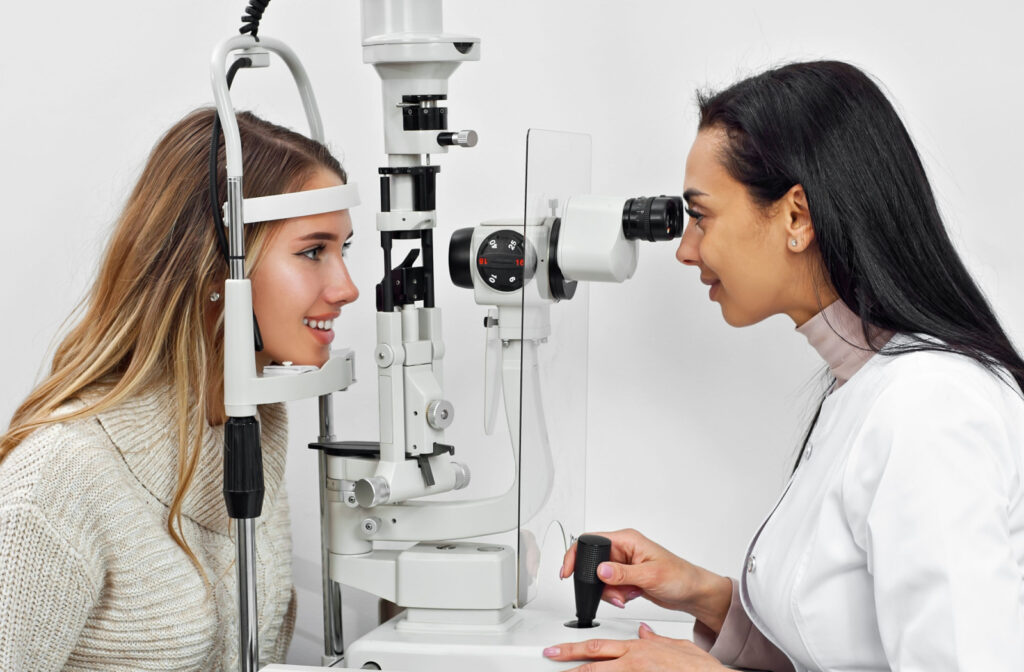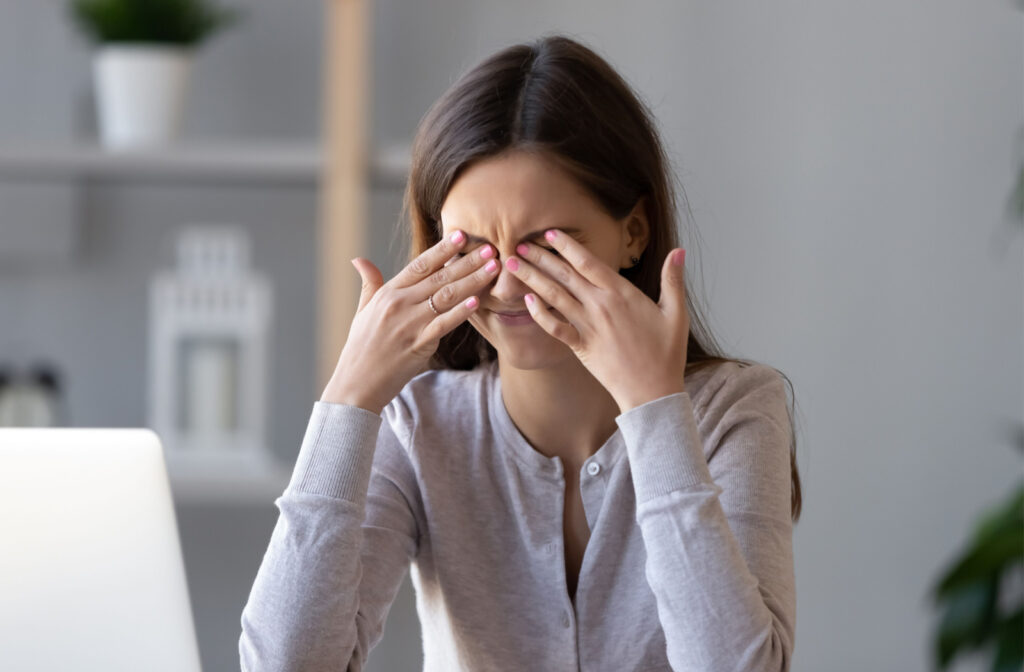Dry eye is a common condition that can make your eyes feel gritty and irritated and even cause blurry vision. Oftentimes, meibomian gland dysfunction (MGD) is the cause of this painful and frustrating condition. If left untreated, MGD can lead to chronic eyelid inflammation, infection, or even vision loss.
Fortunately, there are steps that you can take to unclog your meibomian glands in order to reduce the symptoms associated with MGD and improve your overall eye health with proper management. Meibomian glands can be cleared by using warm compresses, massaging the affected area, taking omega-3 supplements, and through in-office treatments.
Your optometrist can help you determine the cause of your clogged meibomian glands and the options you have to improve the condition.
What Meibomian Glands Are & How They Work
Meibomian glands are oil glands situated along the edge of your eyelids at the base of your eyelashes. They play a vital role in your eye health by producing an oil called meibum. This oil contributes to the outer layer of the tear film, a thin layer of fluid that coats the surface of your eyes.
The meibum is crucial as it serves as a barrier against the dehydration of the cornea, the clear, dome-shaped surface that covers the front of the eye. Furthermore, the oil prevents the water component of tears from evaporating too quickly, keeping the eyes lubricated and comfortable.
However, if these glands become blocked or dysfunctional, it can lead to meibomian gland dysfunction (MGD). In MGD, the meibomian glands don’t secrete enough oil. This can cause the tears to evaporate too quickly, leading to dry eye disease.
Causes of Clogged Meibomian Glands
Clogged meibomian glands can be quite a nuisance, causing dry, irritated eyes. There are several reasons why these glands might get blocked:
- High cholesterol and triglycerides have been linked to MGD. These lipids can thicken the oil produced by the meibomian glands, leading to blockages.
- Allergic conjunctivitis and other eye diseases can also lead to clogged meibomian glands. Inflammation from these conditions can disrupt the normal functioning of the glands.
- Bacterial infections are another common cause. Bacteria can infect the glands, leading to inflammation and blockage.
- Autoimmune diseases like Sjögren’s syndrome or lupus can also cause meibomian gland dysfunction. These diseases can trigger an immune response that affects the glands.
- Age, hormonal changes, certain medications, a dry environment, genetics, and lifestyle factors can also contribute to meibomian gland dysfunction.
- Strain on the eyes, such as from extended computer use, can reduce blinking, leading to less lipid secretion and, eventually, tear film instability.
- Taking multiple drugs to treat 1 condition, especially for age-related conditions, can contribute to meibomian gland dysfunction.
Symptoms of Clogged Meibomian Glands
If you’ve ever experienced dry, burning, or irritated eyes, it’s possible that clogged meibomian glands are the cause. When meibomian glands become blocked, they can cause a variety of symptoms.
These symptoms include:
- Dryness
- Irritation
- Gritty sensation in the eye
- Light sensitivity
- Blurry vision
- Discomfort wearing contact lenses
- Red eyes
If you experience any of these symptoms, it is essential to visit your eye doctor to prevent further complications. Your eye doctor can provide treatment and recommend ways to prevent clogging in the future, such as cleaning your eyelids regularly and using warm compresses.
Natural Treatments for Clogged Meibomian Glands
There are natural treatments available that can help alleviate the symptoms and unclog the glands, such as:
- Using warm compresses on the affected area, which can help to liquefy the blockage and allow it to drain
- Massaging the area around the meibomian glands, which can stimulate blood flow and promote healing
- Using omega-3 supplements may help your body produce enough oils to keep the eyes moist
Limited studies have suggested that tea tree oil, green tea extracts, as well as hypochlorous acid treatments may be beneficial for treating MGD. These ingredients are available in some eye drops formulated for dry eyes. However, it’s essential to consult with your eye doctor before using these natural remedies, as they can advise you on how effective they may be for your condition and how to use them safely.
Other Treatments for Clogged Meibomian Glands
For more severe cases of MGD, your eye doctor may recommend in-office treatments that offer a deep cleaning approach to dealing with MGD, such as the MiboFlow System. The MiboFlow system can be a potential solution for blocked meibomian glands.
These treatments can remove blockages by applying directed heat and gentle pressure, allowing the body to resume the natural production of oils needed for the eyes once the blockage is removed. It works by warming and massaging the inner eyelids, helping release the hardened meibomian lipids that have caused the blockage.
Some doctors also recommend a specialized eyelid cleanser to help improve the oil flow in your glands. Your eye doctor may also recommend medications to improve MGD symptoms.

Tips to Avoid Getting Clogged Meibomian Glands Again
If you’ve ever experienced the discomfort and irritation of clogged meibomian glands, you know how important it is to take steps to avoid this issue.
To reduce the risk of MGD, practice good eyelid hygiene by using a gentle cleanser to remove any debris or makeup from your lids and lashes. Additionally, try to avoid rubbing your eyes or wearing heavy eye makeup that can increase your risk of clogging.
Don’t hesitate to seek medical attention if you’re experiencing chronic discomfort or symptoms such as dry eyes or blurry vision. By taking these simple steps, you can help protect your eyes and keep your meibomian glands functioning well.
Find Treatments for MGD at Pacific Pier Optometry
Meibomian glands are an essential part of eye health. When they become clogged, symptoms like dry eyes and irritation occur. Fortunately, many natural and in-office treatments are available for people with clogged glands.
Pacific Pier Optometry has a variety of MGD and dry eye treatments available to help you find relief. Contact us today for a dry eye consultation and get started on the path to clearer, more comfortable vision.



